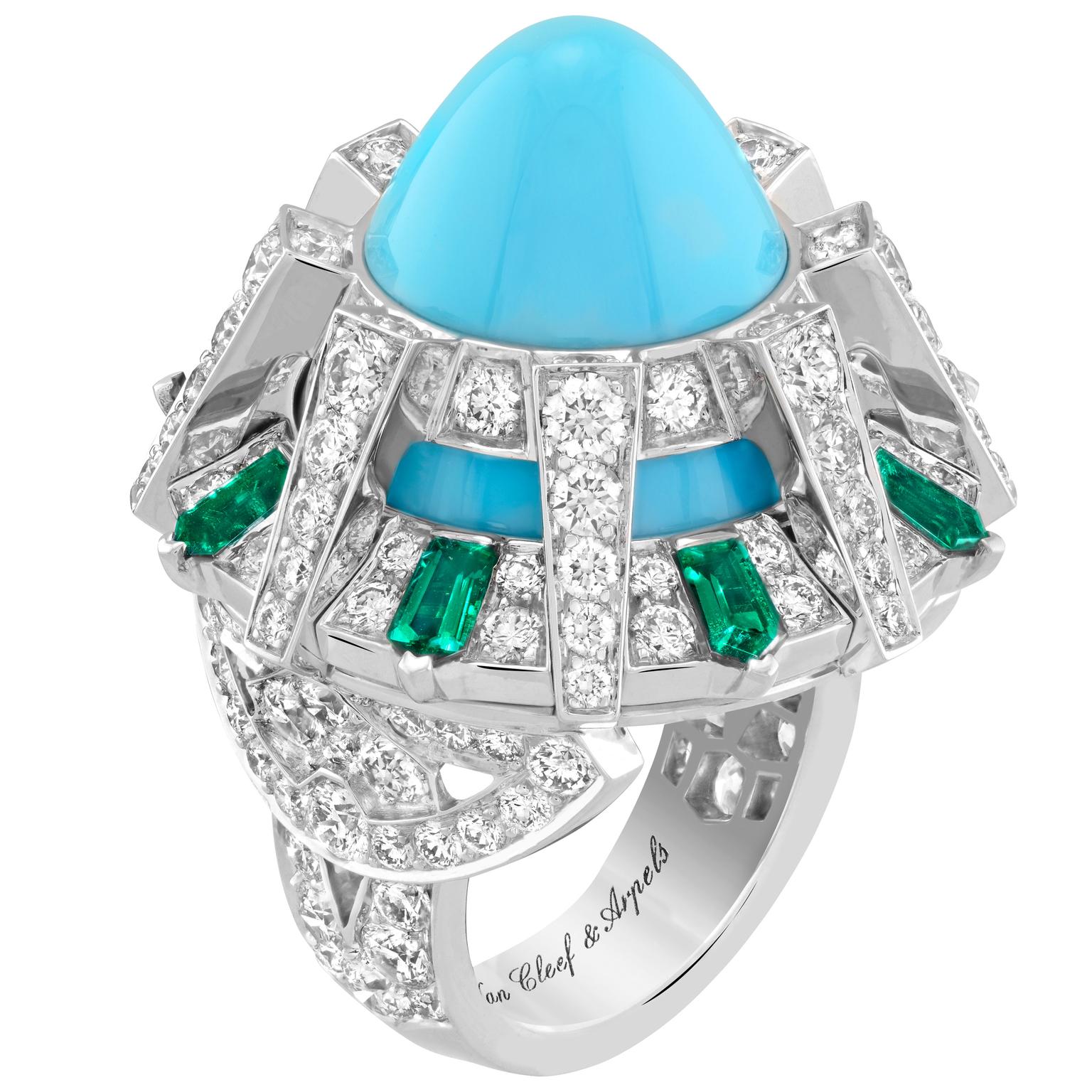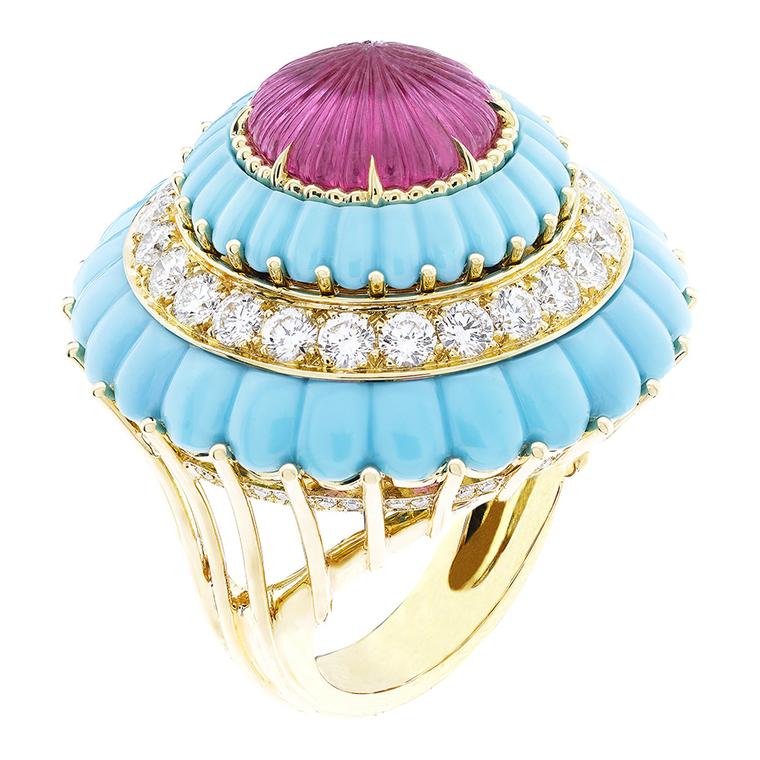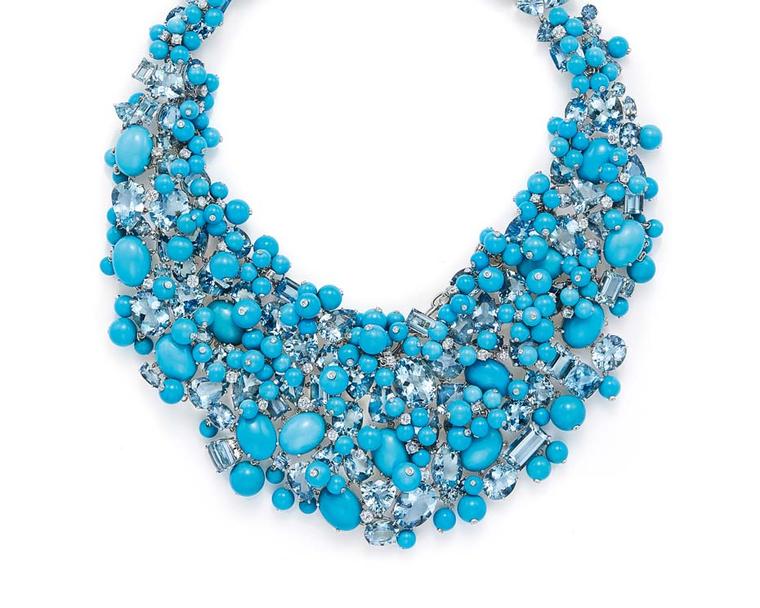An opaque mineral with a waxy lustre that is worn as a gemstone and collected as an ornamental stone, it is enjoying a welcome renaissance in the world of jewellery, with designers falling for its dreamy blue charms in droves.
The word turquoise is derived from the old French word for “Turkish”, referencing the traders who originally exported Persian turquoise to Europe. So vivid and recognisable is its hue that it quickly became more widely used to describe the colour that sits somewhere between blue and green. A gift from the gods believed to bring good fortune to its owners, turquoise continues to be regarded as a potent talisman, with the power to attract prosperity and success.
The beautiful birthstone of December, find out where turquoise is discovered, why the finest turquoise in the world is becoming increasingly rare and valuable and which jewellery designers are doing wonderful things with turquoise.
Where is turquoise found?
Arid climates provided the perfect conditions for the formation of turquoise, with major deposits discovered in Iran (formerly Persia), the American Southwest, the Sinai Peninsula in Egypt and northwest China. Large mines were first recorded around 3,200 BC on the Sinai Peninsula. These included the Maghara Wadi mines, the oldest known source of this vibrant mineral, which produced turquoise for the pharaohs for some 2,000 years.
As early as 2,100 BC, mines were operating in Persia, now Iran – the source of highly prized “Persian turquoise”. Celebrated for its bright, robin’s egg blue colour, for thousands of years, Persian turquoise was regarded as the finest in the world.
The legendary turquoise mines near Nishapur in Iran have been worked for centuries and continue to be mined today, but many of the historic turquoise mines have long since been depleted. Today, China produces the majority of turquoise – around 75%, which is often enhanced for colour and lustre and therefore not considered good quality – alongside Iran, the US, Mexico, Chile and Tibet. In the American Southwest, once a thriving turquoise mining community, many mines are now closed. Those that continue to produce gem-quality turquoise are actually mining copper, with the turquoise a precious by-product.
How is turquoise formed?
A hydrated phosphate of copper and aluminium, the turquoise we wear today is believed to have formed nearly 30 million years ago. The process happened in one of two ways, over many centuries: with water trickling through veins or cracks in a host rock, gradually leaving behind a turquoise deposit, or with nuggets of turquoise forming in clay-filled openings within the rock. Sometimes, a matrix of veins or patterns is visible on the surface of turquoise, which can be grey or gold in colour. If the matrix is thin and evenly spaced, it is commonly referred to as “spiderweb”. For turquoise discovered in the US, a spiderweb matrix increases its collectability. For turquoise found anywhere elsewhere, it has the opposite effect, decreasing its value.
What gives turquoise its unique colour?
The famous sky blue is the colour we are most familiar with, but turquoise is found in a range of hues, from pale powder blue and medium blue to beautiful bright green and yellow-green. Turquoise gets it colour from the metals present in the rock where it was formed, with its chemical composition including either a small amount of copper, which gives turquoise its signature blue colour, iron, which produces a greeny hue, or zinc, which results in a yellowy tone.
Why is turquoise considered semi-precious?
While fine turquoise is becoming rarer and more valuable because less of it is being discovered than at any time in history, turquoise continues to be called a “semi-precious” stone. However much we might like it to be, it is unlikely that turquoise will ever be upgraded to precious, simply because precious is a traditional term reserved exclusively for diamonds, sapphires, rubies and emeralds.
Why is turquoise so desirable?
There are very few minerals on Earth that are coloured blue, particularly the robin’s egg blue that is synonymous with turquoise, which is one of the reasons why this ornamental stone has attracted so many admirers. One of the oldest stones in the history of man, turquoise has had a reputation throughout history as an especially powerful talismanic gem, favoured by warriors, kings and spiritual leaders.
Today, the very best turquoise is more valuable than diamonds, attracting legions of passionate collectors who love to geek out over different origins, colours and matrix variations. With the closure of mines in the US and the turquoise that is left in the world hard to find and increasingly rare, much of the best turquoise is already owned by collectors, which has only served to increase its desirability.
Which is the finest turquoise?
The single most important factor affecting the value of turquoise is its origin, with the finest turquoise displaying an even, intense, medium blue hue. The traditional source of the best-quality turquoise was the Nishapur district of Iran. However, the 20th century saw the American Southwest overtake Iran to become the primary source of the rarest and most valuable turquoise specimens.
Among the most collectable names to look out for are Lander Blue, Number 9, Bisbee and Lone Mountain, together with Sleeping Beauty turquoise found in Arizona’s Gila County. Known for its absolutely flawless coloration, the Sleeping Beauty mine wound down its operations in 2012, causing the value of Sleeping Beauty turquoise to spike and its cachet to soar.
Which jewellery designers are working with turquoise?
Turquoise is increasingly being used by fine jewellery designers in all corners of the globe, who are embracing the pretty punch of colour it brings to their designs. Cut into cabochons or shaped into beads, its vibrant opacity makes it a stunning centre stone.
At David Morris, a turquoise bead is transformed into the juiciest of fruits in the succulent Berry ring, while Bvlgari proves that turquoise is perfectly suited to everyday wear with its stylish turquoise and diamond Diva’s Dream studs.
Taking advantage of the unique veined appearance of some turquoise, New York’s Guita M and California’s Andrea Fohrman combine patterned turquoise with diamonds and pearls in a striking ring and pair of earrings with an earthy, organic feel.
Bringing a boho edge to turquoise jewellery, Shamballa’s beaded bracelet and Jacquie Aiche’s turquoise anklet are the epitome of hippy luxe.
For the ultimate in opulence, there are Bina Goenka’s show-stopping drop earrings. Featuring a frosting of diamond pavé and elegant rows of baguette cut diamonds, they feature vividly colourful beads of the finest Sleeping Beauty turquoise and are utterly exquisite.


































